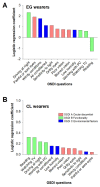OSDI Questions on Daily Life Activities Allow to Detect Subclinical Dry Eye in Young Contact Lens Users
- PMID: 35566752
- PMCID: PMC9101005
- DOI: 10.3390/jcm11092626
OSDI Questions on Daily Life Activities Allow to Detect Subclinical Dry Eye in Young Contact Lens Users
Abstract
Dry eye disease (DED) is difficult to detect in young contact lens (CL) wearers, who usually have no signs, mild symptoms and an ocular surface disease index (OSDI) below the DED diagnosis values (OSDI ≥ 13). We investigate if some of the 12 OSDI questions (OSDI A—ocular symptoms; OSDI B—vision-related functionality; OSDI C—environmental triggers) contribute the most to classify young CL as symptomatic. TBUT and tear volume are also measured. Age, gender and refraction error-matched eye glasses (EG) wearers participated as the control. CL and EG data were compared with t-test and z-test. Confusion matrices and logistic correlation analyses were performed to define the contribution of each OSDI question to classify symptomatic subjects. OSDI classified symptomatic CL better than the tear volume or TBUT values. In CL, only OSDI B and C values were significantly higher in symptomatic vs. asymptomatic subjects (p < 0.001), while values of all twelve OSDI questions were significantly higher in symptomatic vs. asymptomatic EG (p < 0.05−0.001). All OSDI questions contribute equally to identify symptomatic EG, while only OSDI B questions on daily life visual functions are significant to classify symptomatic CL wearers at risk to develop DED or at a subclinical stage. CL wearers scoring ≥ 2 on the OSDI B questions should be considered for preventive treatments, even if their clinical sings are scarce or absent.
Keywords: OSDI; contact lens; daily life activities; dry eye disease symptoms; ocular symptoms evaluation.
Conflict of interest statement
The authors declare no conflict of interest.
Figures



Similar articles
-
Functional Changes of the Ocular Surface Sensory Nerves Due to Contact Lens Use in Young Symptomatic and Asymptomatic Users.Invest Ophthalmol Vis Sci. 2023 Nov 1;64(14):12. doi: 10.1167/iovs.64.14.12. Invest Ophthalmol Vis Sci. 2023. PMID: 37938935 Free PMC article.
-
A novel method to predict the dry eye symptoms in new contact lens wearers.Optom Vis Sci. 2009 Sep;86(9):E1042-50. doi: 10.1097/OPX.0b013e3181b598cd. Optom Vis Sci. 2009. PMID: 19668016
-
Dry eye symptoms and signs in long-term contact lens wearers.Coll Antropol. 2013 Apr;37 Suppl 1:199-203. Coll Antropol. 2013. PMID: 23837244
-
Meibomian Gland Dropout, not Distortion, Can Distinguish Dry Eyes from Normal Eyes in Contact Lens Wearers.Curr Eye Res. 2020 Aug;45(8):897-903. doi: 10.1080/02713683.2020.1731829. Epub 2020 Mar 2. Curr Eye Res. 2020. PMID: 32066267 Review.
-
The Influence of Lid-Parallel Conjunctival Folds and Conjunctivochalasis on Dry Eye Symptoms with and Without Contact Lens Wear: A Review of the Literature.Ophthalmol Ther. 2024 Mar;13(3):651-670. doi: 10.1007/s40123-023-00877-9. Epub 2024 Jan 13. Ophthalmol Ther. 2024. PMID: 38217793 Free PMC article. Review.
Cited by
-
The severity of dry eye symptoms and risk factors among university students in Saudi Arabia: a cross-sectional study.Sci Rep. 2024 Jul 2;14(1):15149. doi: 10.1038/s41598-024-65297-6. Sci Rep. 2024. PMID: 38956213 Free PMC article.
-
Prevalence and Associated Risk Factors of Dry Eye Disease Among Children and Adults in Saudi Arabia: A Cross-Sectional Study.Cureus. 2023 Jun 9;15(6):e40170. doi: 10.7759/cureus.40170. eCollection 2023 Jun. Cureus. 2023. PMID: 37431337 Free PMC article.
-
Improvement of contact lens-associated dry eye disease with the use of hydrogen peroxide.PeerJ. 2024 Dec 6;12:e18482. doi: 10.7717/peerj.18482. eCollection 2024. PeerJ. 2024. PMID: 39655327 Free PMC article.
-
Evaluation of changes in objective visual quality based on tear film stability after SMILE surgery.Front Med (Lausanne). 2025 Apr 25;12:1538359. doi: 10.3389/fmed.2025.1538359. eCollection 2025. Front Med (Lausanne). 2025. PMID: 40351463 Free PMC article.
-
Daytime Changes in Tear Film Parameters and Visual Acuity with New-Generation Daily Disposable Silicone Hydrogel Contact Lenses-A Double-Masked Study in Symptomatic Subjects.Vision (Basel). 2024 Mar 5;8(1):11. doi: 10.3390/vision8010011. Vision (Basel). 2024. PMID: 38535760 Free PMC article.
References
-
- Abetz L., Rajagopalan K., Mertzanis P., Begley C., Barnes R., Chalmers R. Development and validation of the impact of dry eye on everyday life (IDEEL) questionnaire, a patient-reported outcomes (PRO) measure for the assessment of the burden of dry eye on patients. Health Qual. Life Outcomes. 2011;9:111. doi: 10.1186/1477-7525-9-111. - DOI - PMC - PubMed
-
- McMonnies C.W., Ho A. Responses to a dry eye questionnaire from a normal population. J. Am. Optom. Assoc. 1987;58:588–591. - PubMed
Grants and funding
LinkOut - more resources
Full Text Sources

